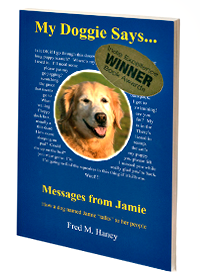I was the speaker at a local event yesterday, and a member of the audience said, “Didn’t you write a book about how to talk to your dog?” (I get this question often.) My answer was, “No, it’s about your dog talking to you!”
It’s important to remember, if you want to have a close relationship with your dog, that relationships — and communication — work two ways. You talk to your dog, and your dog talks to you. The problem is, you and your dog probably speak different languages.
“My Doggie Says… Messages from Jamie” is a collection of photographic (color) examples of the messages my Golden Retriever, Jamie, sent as part of her every-day communication. The point of the book is that, by observation, you can learn to understand your dog’s messages, which are almost always sent by “body language.”
Much of our training (and reading) about how to work with our dogs focuses on teaching them to respond to certain commands, like “sit,” “stay,” “down,” “speak,” etc. Callie (Jamie’s successor) is going through this “puppy kindergarten” training right now (Lomita Obedience Training Club) The focus here is on sending messages to your dog, including using a “clicker” to tell your dog, “A yummie puppy treat is on it’s way!” The clicker reinforces the puppy treat reward for good behavior, and it is becoming an important part of sending messages to your dog. (Here’s a good article on “clicker training.”)
But the other side of communication is learning to listen to what your dog is saying, which really means observing your dog’s behavior and figuring out what messages it might be sending.
For example, when your dog or puppie jumps on you, you can try to correct it by yelling “no” or “wrong,” but the “dog body language way” is to either turn away (expressing dissatisfaction) or follow the advice of this article from The How-To Lounge. It suggests grabbing your dog’s front paws and forcing it to stand on it’s hind legs, which it will not like. You release the front paws after a few seconds and say “OFF.”
To have a closer relationship with your dog, make sure you’re speaking (and hearing) it’s language.
















